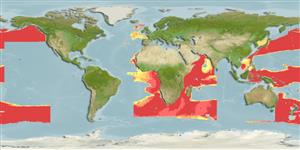>
Lophiiformes (Anglerfishes) >
Caulophrynidae (Fanfins)
Etymology: Caulophryne: Greek, 'kaulos' or 'caulis' = stem + Greek, 'phryne' = toad (according to Goode and Bean (1896): "a 'phryne'-like fish with the cephalic tentacle supported on a stemlike base") ( Ref. 86949).; pelagica: Named for Theodore W. Pietsch..
Environment: milieu / climate zone / depth range / distribution range
Ecologia
marino batipelagico; distribuzione batimetrica 954 - 2500 m (Ref. 40966). Deep-water
Circumglobal.
Size / Peso / Age
Maturity: Lm ? range ? - ? cm
Max length : 15.0 cm SL (female)
Short description
Morfologia | Morfometria
Raggi dorsali molli (totale): 14-17; Raggi anali molli: 12 - 16. Metamorphosed females distinguished by the following characteristics: stem of illicium is naked, without translucent filaments along length; length of illicium 18-125.8%SL; esca consisting of 5-7 elongate filamentous appendages; 2-4 appendages more proximal in position, bearing none to several side branches, 3-4 more distal appendages bearing numerous side branches; opaque areas absent; teeth in upper jaw 28-40; lower jaw teeth 20-34; teeth of vomer 2-5; dorsal fin rays 14-17; anal fin rays 12-16; pectoral fin rays 14-18 (Ref. 86949).
Life cycle and mating behavior
Maturità | Riproduzione | Deposizione | Uova | Fecundity | Larve
Pietsch, T.W., 1999. Caulophrynidae. Fanfin anglerfishes (deep-sea anglerfishes). p. 2026. In K.E. Carpenter and V.H. Niem (eds.) FAO species identification guide for fishery purposes. The living marine resources of the WCP. Vol. 3. Batoid fishes, chimaeras and bony fishes part 1 (Elopidae to Linophrynidae). FAO, Rome. (Ref. 12941)
IUCN Red List Status (Ref. 130435)
Threat to humans
Harmless
Human uses
Pesca: di nessun interesse
Informazioni ulteriori
Nomi ComuniSinonimiMetabolismoPredatoriEcotossicologiaRiproduzioneMaturitàDeposizioneSpawning aggregationFecundityUovaEgg development
Age/SizeAccrescimentoLength-weightLength-lengthLength-frequenciesMorfometriaMorfologiaLarveDinamica popolazioni larvaliReclutamentoAbbondanzaBRUVS
BibliografiaAcquacolturaProfilo di acquacolturaVarietàGeneticaElectrophoresesEreditarietàMalattieElaborazioneNutrientsMass conversion
CollaboratoriImmaginiStamps, Coins Misc.SuoniCiguateraVelocitàModalità di nuotoArea branchialeOtolithsCervelliVista
Strumenti
Special reports
Download XML
Fonti Internet
Estimates based on models
Preferred temperature (Ref.
123201): 2.5 - 6, mean 3.7 °C (based on 1051 cells).
Phylogenetic diversity index (Ref.
82804): PD
50 = 0.5938 [Uniqueness, from 0.5 = low to 2.0 = high].
Bayesian length-weight: a=0.01000 (0.00244 - 0.04107), b=3.04 (2.81 - 3.27), in cm total length, based on all LWR estimates for this body shape (Ref.
93245).
Trophic level (Ref.
69278): 3.9 ±0.7 se; based on size and trophs of closest relatives
Fishing Vulnerability (Ref.
59153): Low vulnerability (10 of 100).
